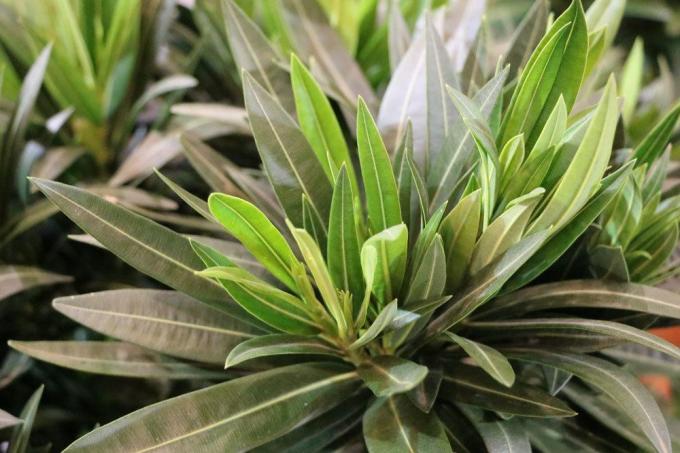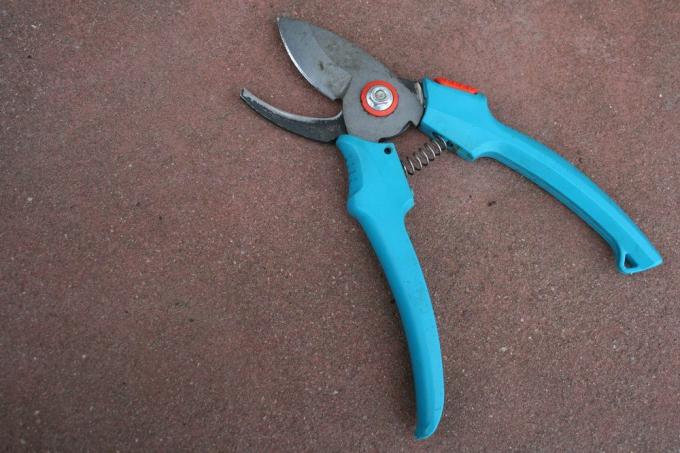
table of contents
- wintering
- preparation
- Outdoors
- Winter quarters
- care
- After the winter
- Cut
With its Mediterranean flowers it counts oleander the most popular container plants. Due to its natural origin, the flowering wood, also known as rose laurel, is only partially hardy in this country. In cold locations, it needs appropriate winter quarters, while a few species in particularly mild regions, with appropriate protection, can also overwinter outdoors. Regardless of the variety, however, there are a few things to consider in order to get these attractive plants through the winter unscathed.
wintering
Winter in the house
Like most of the Mediterranean potted plants, the oleander (Nerium oleander) can only tolerate light frost up to a maximum of minus 5 degrees. As a result, he has to spend the winter indoors in most regions of Germany. Nevertheless, he should stay outside as long as possible but also get back outside as early as possible.
In order to be able to leave the plants outside as long as possible, they can be wrapped in a fleece to protect them from cold temperatures and placed in a protected place near a house wall. Late autumn also has a few warm days that should be used for the sake of the oleander. This hardens the plant so that it can survive the winter in the house better, because many look quite worn out in spring.

preparation
Prepare for wintering
Depending on the weather and the risk of frost, it will be time for the rose laurel to move to its winter quarters around the beginning of November. Before that happens, however, there are still minor maintenance measures to be taken. The oleander must be checked for possible pest infestation by spider mites or scale insects and, if present, it must be eliminated. It is also advisable to remove any weeds from the earth. It is better to postpone pruning measures to the time after wintering in early spring.
The plant can only be pruned minimally if the space available in the winter quarters is limited. To save space, shoots that are too long can be loosely tied together. However, one should make sure that the inside of the plant is still adequately ventilated.
Outdoors
Even if oleander is only partially hardy, it can also overwinter outside in mild winter regions under certain conditions. Only a few varieties are suitable for wintering in this way. The hardest of frosts are Nerium Oleander 'Italia', Nerium villa romaine, Nerium atlas and Nerium cavalaire. However, they cannot do without good winter protection either. This affects the above-ground parts of the plant and especially the root ball.
- choose a sheltered place to hibernate
- if possible in front of a house wall, under a roof overhang
- Place the bucket on a wooden pallet or a 5 cm thick styrofoam plate
- this protects the bale from ground frost
- Wrap the bucket loosely with warming materials
- Jute, fleece, bubble wrap, bamboo or coconut mats are suitable
- cover the soil with a layer of mulch
- Fill straw or dry leaves between the bucket and the casing
- then fix the whole thing with a string
- To protect above-ground parts of the plant, loosely tie the branches together with a cord
- then put a light and air permeable garden fleece over the plant
- for watering on frost-free days, leave a small opening in the cover

Tip: If, despite the mild location, longer periods of frost with temperatures below minus 5 degrees are announced, it is advisable to move the plant to a frost-free basement or garage to be on the safe side to fetch.
Winter quarters
The ideal winter quarters
You should choose the location for the winter well, because oleanders do not like it at all if they are moved one or more times during the hibernation. In addition, you shouldn't just put it in the apartment. The apartment, especially the living room, is the worst possible place for wintering. As a rule, the apartment is way too warm and not bright enough in winter. Powerless, wilted, shoots would very quickly develop which would not be viable in the open air.
- Evergreen rose laurel would like to be bright in winter
- the cooler the room, the darker the oleander can stand and vice versa
- cool temperatures, generally a must in winter quarters
- Room temperatures between two and ten degrees are considered optimal
- that alone excludes the living room as winter quarters
- what is still important is good ventilation
- this is supposed to prevent diseases and pests
- at best overwinter in a bright cold house, unheated winter garden or greenhouse
- also suitable for bright and cool stairwells
- Basement too dark and too warm in most cases
- therefore only recommended in exceptional cases
- Use plant lamps if necessary for more brightness
At temperatures above 15 degrees, the risk of pests or diseases as well as horny growth or crippling is significantly increased. Those who do not have the opportunity to properly overwinter oleanders can, if necessary, take advantage of the overwintering service that is offered by some tree nurseries and garden centers. Going into the living room is not a good idea.
Tip: If a light overwintering is not possible, oleander can also overwinter a little darker and then above all cooler, for example in a cool cellar or a frost-free garage.
care
Care in winter quarters
Of course, rose laurel cannot be left to its own devices in winter quarters. Even now he needs a minimum of care. It should be watered significantly less, as the need is lower during the winter time and the earth does not dry out as quickly in the cool temperatures. Despite everything, the root ball should not dry out completely. It is usually sufficient to give a little water once a week.
The cooler the room, the less water has to be poured. Regular checks for pest infestation are no less important in order to eliminate them as early and as quickly as possible. In addition, regular ventilation should be provided on frost-free days. There is no fertilization in winter. Fertilize until September and then start fertilizing again in spring after clearing out.

After the winter
As mentioned earlier, rose laurel should go back outdoors as early as possible. However, this is not possible without a short acclimatization phase. As long as stronger frosts are predicted, you should wait to get used to it. This plant usually copes well with light night frosts, which can certainly occur in spring.
Plants that have been overwintered cooler than 10 degrees can be outside as early as the end of March / beginning of April, depending on the weather. Specimens that were housed at 10 or more degrees have often already started to sprout in their winter quarters. Since these young shoots are particularly susceptible to frost, you should possibly Wait a little longer, if necessary until the ice saints.
Cut
Cut back after the winter break
Before you finally put the oleander back into the open, it should be cut back. The best time to do this is in early spring, unless pruning has taken place before wintering. The pruning ensures a lively new shoot and protects the plant from balding.

- to do this, cut back one or more old shoots to 10-20 cm
- Cutting into the old wood mainly stimulates the formation of long shoots and leaf mass
- Pruning in the flowering region promotes the formation of short, relatively quickly flowering shoots
- Do not cut off inflorescences!
- at their tips are the plants of the new flowers
- used inflorescences, the plant repels itself
- removing the seed heads is advantageous
- they cost the plant a lot of strength
Tip: It is important to wear gloves when cutting, as the sap that escapes is poisonous and can cause skin irritation.



